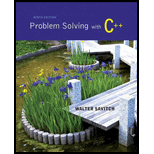
Concept explainers
Give the function definition for the function with the following function
declaration. Embed your definition in a suitable test
| void getDouble(double& inputNumber); //Postcondition: inputNumber is given a value //that the user approves of. |
You can assume that the user types in the input in normal everyday notation, such as 23.789, and does not use e-notation to type in the number. Model your definition after the definition of the function getInt given in Display 8.3 so that your function reads the input as characters, edits the string of characters, and converts the resulting string to a number of type double. You will need to define a function like readAndClean that is more sophisticated than the one in Display 8.2, since it must cope with the decimal point. This is a fairly easy project. For a more difficult project, allow the user to enter the number in either the normal everyday notation, as discussed above, or in e-notation. Your function should decide whether or not the input is in e-notation by reading the input, not by asking the user whether she or he will use e-notation
Want to see the full answer?
Check out a sample textbook solution
Chapter 8 Solutions
Problem Solving with C++ (9th Edition)
Additional Engineering Textbook Solutions
Vector Mechanics For Engineers
Management Information Systems: Managing The Digital Firm (16th Edition)
BASIC BIOMECHANICS
Computer Science: An Overview (13th Edition) (What's New in Computer Science)
Electric Circuits. (11th Edition)
Java: An Introduction to Problem Solving and Programming (8th Edition)
 C++ Programming: From Problem Analysis to Program...Computer ScienceISBN:9781337102087Author:D. S. MalikPublisher:Cengage Learning
C++ Programming: From Problem Analysis to Program...Computer ScienceISBN:9781337102087Author:D. S. MalikPublisher:Cengage Learning C++ for Engineers and ScientistsComputer ScienceISBN:9781133187844Author:Bronson, Gary J.Publisher:Course Technology Ptr
C++ for Engineers and ScientistsComputer ScienceISBN:9781133187844Author:Bronson, Gary J.Publisher:Course Technology Ptr Microsoft Visual C#Computer ScienceISBN:9781337102100Author:Joyce, Farrell.Publisher:Cengage Learning,
Microsoft Visual C#Computer ScienceISBN:9781337102100Author:Joyce, Farrell.Publisher:Cengage Learning,


